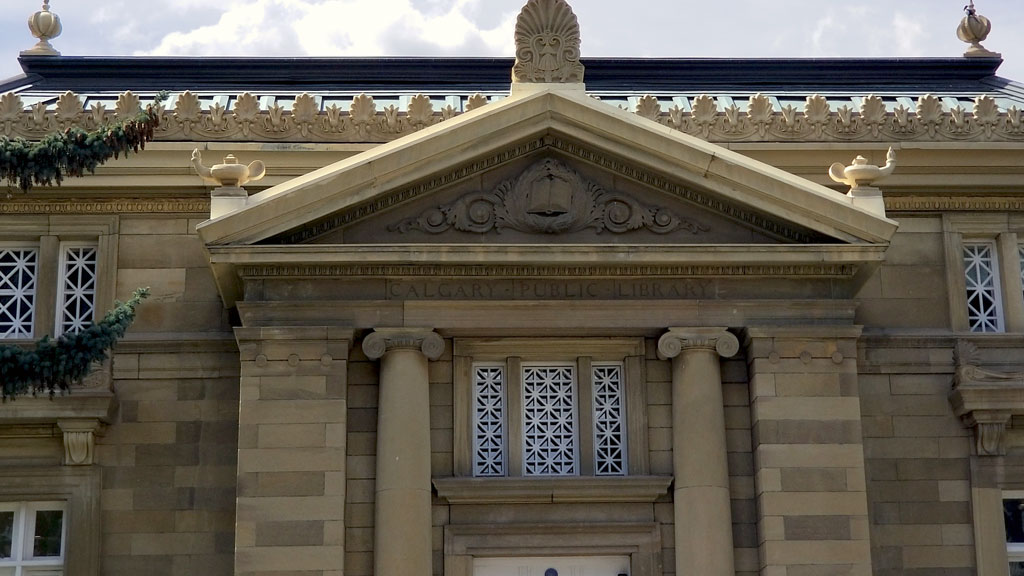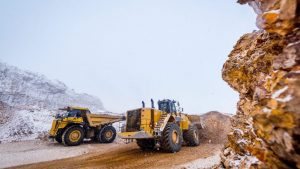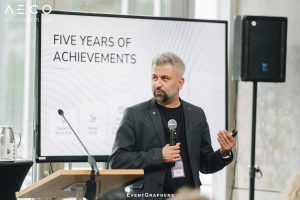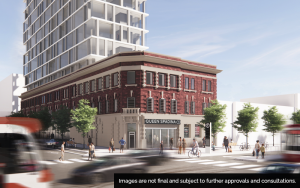Western Canada’s colourful history is literally written in stone; its guardians a highly skilled but select construction group of heritage and restoration masonry companies that maintain castles, heritage structures and institutions such as Legislatures, universities, courts, and city halls.
Masons themselves draw from a rich past of tradition and even mystery — as master masons kept the techniques of building Europe’s finest structures secret. Masons were also held in such high regard that they were not required to bow to kings and queens. While the social position of masons may have changed, the masonry skills involved in maintaining these ageless structures have not.
“It is a niche and a specialty,” said Shawn Thibault, a stone conservator who works with masonry, stone and brick and also does architectural stone carving. He was drawn to the industry after seeing how the old stone buildings in Europe and Asia captured a country’s heritage. Canada didn’t have the same reverence. “We bulldoze them if they are old,” he said, adding that partially resulted from the inability to maintain them. Reduced to rubble, heritage was lost. “We miss the stories that these buildings tell,” he said.
Governments today are moving toward greater preservation, he said as his company Ravenstone works throughout Western Canada. He has standing contracts to maintain Victoria’s Craigdarroch Castle (the legacy of coal baron Robert Dunsmuir who lured Scottish masons over to build it), the Memorial Park Library (in Calgary) and has worked on restoration projects such as Victoria’s Wharf Street, View Royal Kiln Ruins, Fort McLeod’s Empress Theatre, and numerous provincial and federal buildings.
The whole process begins by learning how the building was constructed by early masons. “It is a little bit like being a detective,” Thibault said. He then attempts to replicate that process as much as possible right down to the mason’s chisel strokes on a carving or searching for matching stone – even as far as Barcelona on one occasion.
We have actually made our own tools to create the finishes when the tools are not around anymore,
— Shaun van den Kerkhof
Van den Kerkhof and Son Masonry
The main flaw in restoration that Thibault and conservators see is the use of modern masonry to repair old buildings, which were designed to ‘breathe’. A lime mortar, derived from high-calcium sources ranging from buffalo bones to B.C.’s common lime stone (heated to drive off the carbon) and then pulverized, mixed with sand and water, formed the binder between hard stone. “The mortar was the sacrifice,” he said, as this soft mortar served as conduit for escaping water. Modern-style repairs replaced mortar with cement that is too hard; driving moisture into the rock leading to deterioration.
When these older buildings were constructed, the mason mixing the mortar was the most skilled on site as he varied the mix according to its placement on a structure and its exposure to the elements. “Today, that is flipped around,” he said, adding that on modern construction sites today, the mortar mixes usually arrive in a bag and a laborer will mix the mortars.
As well, there is a degree of art to these older buildings as early masons didn’t have lasers to level or create straight lines Using that technology today can result in restoration work that looks off. “You need an artistic eye to make it look right,” said Thibault. Basic restoration tools are a hammer and chisel and “extreme patience”, he said.
Third generation mason Shaun van den Kerkhof of Van den Kerkhof and Son Masonry agrees. It is not work that every mason can take on as there are no quick fixes and requires a dedication to detail right down to replicating the finishing. “We have actually made our own tools to create the finishes when the tools are not around anymore,” he said.
“Ninety per cent of what we do is restoration of heritage buildings,” said Van den Kerkhof. His company has been a go-to on some of Vancouver’s landmark structures including the Marine Building, the Spencer Building, the Rogers Mansion conversion, and is now working on the iconic Sun Tower (once the World Tower as it was the tallest structure in the British Empire for a few years and home to two of Vancouver’s dailies) and St. Andrew’s-Wesley United Church in Vancouver.
On the 1912 Beaux-Arts Sun Tower, Van den Kerkhof’s crew (subcontracting to a Winnipeg-based company) is charged with a seismic upgrade, repairing and replacing terra cotta on the building’s exterior and preserving its exterior statutes, which are a part of Vancouver’s colourful history. The Sun Tower was built by L.D. Taylor, a former mayor and publisher, who shocked Vancouver’s hat-and-gloves sect by placing semi-nude The Nine Maidens on the eighth floor exterior.
St. Andrew’s-Wesley Church is the largest project the company has undertaken. “It is perhaps the most interesting restoration,” said van den Kerkhof, as the 1933 14th-Century style Gothic structure designed by Twizel and Twizel, requires a seismic upgrade that will see a virtually a new building inside an older one and tying the two together after taking down the interior. “We have a building that is just full of art,” he said, adding those features are being detailed in AutoCAD, moulds and recreations done and then everything is assembled back to its original decor over a two-year period.
It’s not uncommon for large projects to run into years. Currently, Alberta’s Scorpio Masonry is working on a $20 million contract to restore the Legislature in Edmonton. The number of repairs needed? Approximately, 18,000. “We will be working into 2022,” said Scorpio president Chris Ambrozic of the 36-month contract.
The diverse skill needed by masons is the reason that Ambrozic trains in-house. “It is more of a mentality,” he said, as patience needs to be combined with a willingness to learn about the varying processes that change from job to job. Scorpio has also been involved in a number \of projects where the facade of a structure has been catalogued and stored and then reassembled when the structure has been upgraded. Restoration projects have included: the Kelly Ramsey building, the Federal Building, First Presbyterian Church, and Le Marchand Mansion.
Calgary’s Jamie Sorenson is the third generation of masons within Ib Jensen Masonry, a company started by Danes in the 1960s, who brought European heritage masonry techniques together into a company named for Ib Jensen. “Ib had the most equipment,” said Sorenson, so the others merged their companies into his.
“They used European techniques for stone restoration and that was kind of how we got into it,” he said. “We were also fortunate to find Paskapoo sandstone. It was in southern Alberta in a development near Calgary, in a hillside. It was offered to us and we took as many of the large boulders as we could. It managed to last us a good many years and we used that restoration material for some time (it is now depleted).”
The company is known for its restoration work on pedestrian walk Calgary’s Stephen Ave., built in the early 1900s, and today a downtown convention and tourism area full of Paskapoo stone buildings, a style that resulted after Calgary’s downtown burned in 1886 with a subsequent bylaw restricting construction to Paskapoo sandstone.
“Masonry is timeless,” said Sorenson, adding the skilled architectural style and the use of buff colored sandstone lends a warmth and ambiance to many of the city’s older areas that is difficult to replicate today. The company has worked on notable structures such as the Peter Lougheed House, Imperial Bank, and the Thomson Bros. Block.
Sorenson said that it often surprises people to learn the degree of artistry required in restoration work. “It is an artistic hands-on skill and not a mechanical one,” he said, as buildings of past eras were highly decorative. Past masons carved those decorations and masons today continue that hands-on tradition.
Victoria’s Gavin Chamberlain of Heritage Masonry grew up in northern England surrounded by old masonry and began working stone early in his youth helping restore 200-year-old dry stone walls on an uncle’s farm. Today, he leads and trains masons in-house on the art of restoration, plus the usual scope of work masons perform including building dry stone walls for residential properties.
His company has worked on restoration projects at the Department of National Defense’s Fort Rodd Hill National Heritage Site, Christ Church Cathedral Memorial Hall, Christ Church Cathedral and school, Hatley Castle, and 120 Douglas Street in Victoria.
The challenge that Chamberlain sees is getting owners and consultants to do the job right the first time. “Fortunately, I’ve worked for owners and consultants who have an understanding of such buildings and we are all coming from the same place.” But, in today’s environment of fast-paced construction, it can be a challenging environment to bid on projects against those companies that adhere to a lesser standard.











Recent Comments